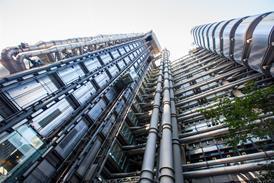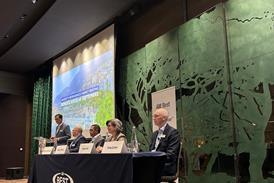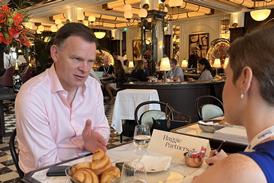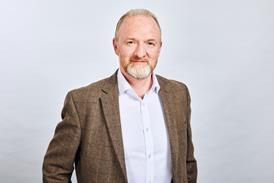Composite panels used in building construction are blamed for £60m worth of fire damage each year. A product has been launched that is intended to bolster underwriters' confidence in the food storage and manufacturing sector. Francis Higney reports
Fire in the food sector is a big safety worry. The ABI recently held a forum on the future of construction using composite panels. These are so-called sandwich panels used to build food production and warehousing facilities. The panels consist of two thin metal skins (the bread) flanking a core of insulating material (the filling).
Every year, it is said, insurers see £60m go up in smoke in this sector. And underwriters suspect composite panels play a major role. The problem has now become so great that an ever-increasing number of insurers are refusing cover to commercial properties most at risk from a loss involving fire.
Fire hazard
The problem, according to underwriters, is that the insulating materials, polystyrene and polyurethane, can produce toxic fumes or collapse in the event of a fire. Many of the buildings made from these panels that suffer a fire result in total loss, say underwriters. It is estimated that insurers pay out five times as much in claims than they receive in premiums when insuring these premises. Manufacturers say that as long as they are installed correctly, the panels are not a risk. Whatever the truth, the perception is that buildings made from the panels are high risk.
Underwriters have two strategies - vastly increase premiums and excesses (increases of over 200% have been witnessed recently), or walk away from the business altogether.
Heath Lambert projects director Dave Barnes says the market has struggled to take up the slack following the collapse of Independent Insurance, the market leader in underwriting this type of risk.
"We have told the construction industry that if you are bidding for the construction of these sorts of premises, be aware of the inherent problems with insurance. And it has been taking this on board."
New product
Brokers have a tough job finding cover for their clients, but this could change with the development of a new product. British researchers have developed a product which can be used in composite panels which doesn't burn, emit toxic fumes and is flexible enough to be cut and moulded.
Crucially, it can be manufactured, according to the inventor Paul Burling, at a price that is competitive with existing products on the market.
The product is called Barrikade. But is it as good as Burling claims?
That is how I came to find myself, in the company of brokers and underwriters , in the verdant Cambridgeshire countryside on a magnificent autumn morning at the premises of The Welding Institute.
There was to be a demonstration. They were going to set fire to things.
We learned about materials currently used in the construction of composite panels - polystyrene, polyurethane and PIR.
"Barrikade reaches an optimum temperature of 160 degrees Celsius when exposed to flame and will not exceed this. It can also be cut and sliced like a breeze block, unlike mineral wool," says Burling.
The demonstration seemed to convince the audience, with one impressed industry figure going as far as to brand it "the Rolls-Royce of building materials".
Size matters
It does have something in common with a Roller - size.
"You need twice the thickness of Barrikade to provide the same amount of insulation as mineral wools provide," confesses Burling. "It's the product's only drawback, as it will result in some cost implications."
However, he believes that the material's flexibility and fire resistance more than compensates.
And he points out that it can be used as a non-fibrous coating to protect heat sensitive structures - a bonus in buildings designed for food storage or preparation.
But it's one thing to convince a group of insurers and brokers about the merits of Barrikade and quite another to convince moneymen to back mass production of the so-called wonderwall.
"It's difficult getting the product into industry," admits Burling, "but we did have a bit of luck with the introduction of a new European standards Directive."
This concerned the replacing of the BS standard on fire doors with a new European standard.
It has resulted in the fire resistant properties of Barrikade being employed in the construction of new fire doors. Another breakthrough has seen Barrikade panels being used in the construction of trains for the London Underground.
However, its use in composite sandwich panels for the construction industry is the big prize, and although licences for manufacture have been issued, no production on any scale has yet been attempted here.
Jeff Laidler of broker Shephards says: "It is a problem. The construction industry is only interested in putting a building up as quickly and as cheaply as possible."
And products exist in the market that perform adequately and have Loss Prevention Council accreditation.
Allianz Cornhill UK risk survey manager Andrew Miller says: "If the insurance industry is going to use this product, either externally or internally, the thermal insulation value is critical.
"Having to double the sandwich panel in size could also put too much weight on the building frame.
"It has to be cost-effective if industry is going to accept it. And combustibility is not the only factor.
"We think there are a number of questions that remain to be answered [concerning Barrikade], but we are not dismissing it out of hand."
Impartial tests
Cornhill will not take it seriously until it has undergone extensive independent testing with the Building Research Establishment (BRE), says Miller.
The BRE is a privatised former government agency and the UK's leading centre of expertise on building and construction, and the prevention and control of fire.
When the BRE completes its testing of the panels it will pass its findings on to the Loss Prevention Council for accreditation.
The BRE had a representative at the demonstration. He seemed impressed, but stressed that he could not make any official comment until after the testing process was complete.
The ABI was scheduled to hold a seminar on composite panels on 9 October. A spokeswoman for the ABI was reluctant to divulge details of the agenda, but did say the results of a series of research studies into composite panels would be presented.
Strangely, although invited to the Barrikade demonstration, the ABI declined to send a representative.
Surely it was not because it feared jeopardising the results of its own research?









































